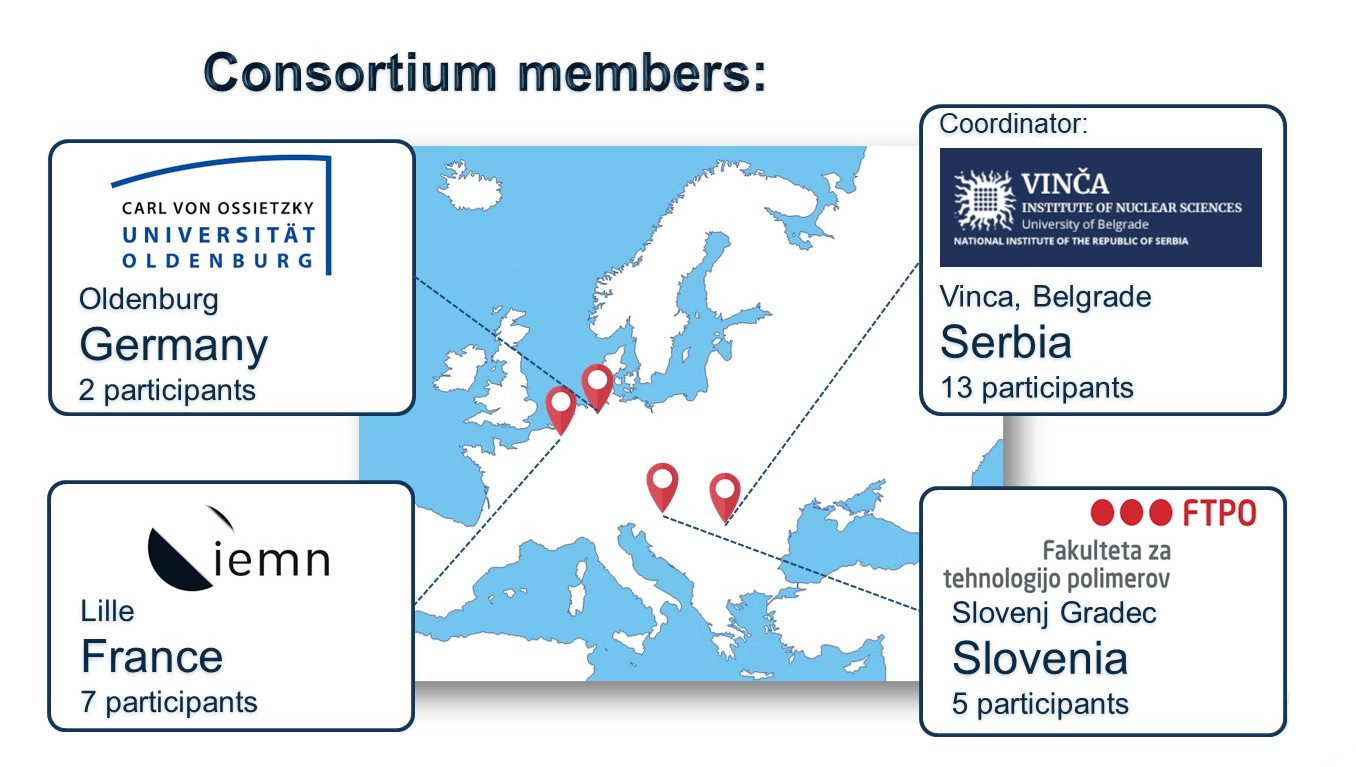About Us

Consortium members:
Institut za Nuklearne Nauke Vinca, Institut od Nacionalnog Značaja za Republiku Srbiju (VINCA) is the Nation’s largest (800 employees, 521 researchers) and one of the oldest scientific institutions in the Republic of Serbia (est. in 1949). Although founded as a nuclear facility, today it is a multidisciplinary institute with a unique combination of facilities (such as a gamma irradiation unit), but also covers the areas of physics, chemistry, biology, nanoscience, etc. The annual scientific production is close to 500 peer-reviewed articles in Material Science, Physics, Engineer research, Chemical, Biological journals (ACS Nano, Carbon…). The department for radiation chemistry and physics “GAMA” has 12 Ph.D. students, and 59 full-time researchers. Apart from national, several international projects are implementing in GAMMA laboratory: NanoTbTech (finished in 2021); NATO: ORION Project (2020-2023); bilateral projects: Slovenia, Austria, India, China, Slovakia, Portugal; Multilateral projects (3): Cooperation Projects in the Danube Region; Serbian science cooperation program with the diaspora (3); International Atomic Energy Agency (IAEA) projects (6).
Fakulteta za Tehnologijo Polimerov (FTPO) is a young (founded in 2006), small, private and non-profit faculty. It was founded by several companies, institutes and the municipality of Slovenj Gradec. It is the only institution in Slovenia and in the Balkan region that offers a holistic study programme on polymer technology and focuses its research on this important topic. There are 20 employees and 120-150 students.
Since 2006, FTPO has grown from a school with only a few personal computers and no research equipment to a respectable research institution. Since its inception, the goal of the staff has been to focus more, but not only, on applied science, especially in polymer processing and the field of biomaterials. Close cooperation with industry and research institutions in Slovenia and abroad, especially in Austria, has allowed FTPO to attract several research and cooperation projects, which enabled the purchase of numerous pieces of equipment for polymer synthesis, (FTPO is very well equipped for polymer synthesis from gram scale to 2 kg/batch), characterization and processing. Some of the processing equipment was also donated by various companies (Arburg injection moulding machine, laser engraving machine,…) Some of the research equipment is unique in Slovenia, such as the Flash DSC and the 2.5 L metal reactor, specially designed for the synthesis of even the most viscous polymers, such as PET.
University of Lille is one of the leading science universities in France, with around 20000 students and 2975 staff members (Academic and Administrative). Research is organised around 5 Institutes and 3 Research Centres. These 8 scientific areas have developed a strong strategy with National and International authorities under its 37 key laboratories. Lille 1 possesses 5 doctoral schools. 1100 candidates of which 30% are international are registered in these doctoral schools and about 220 theses are defended per year.
The Institute of Electronics, Microelectronics and Nanotechnology (IEMN) is a public laboratory within the University of Lille, CNRS, University of Valenciennes, École Centrale Lille and ISEN-Lille. The laboratory gathers 480-500 people including permanent staff: 45 full-time CNRS researchers, 114 professors and assistant professors and 68 engineers and technicians. IEMN is a strong actor as a training center in the field of nanoscience with 140 PhDs students, 60 undergraduate students, and 30 Postdocs.
The laboratory gathers five scientific departments:
– Materials and nanostructures ;
– Micro and nano-systems ;
– Micro nano and optoelectronics ;
– Circuits and communication systems ;
– Acoustics.
IEMN gathered five large experimental platforms:
– The ‘Micro and Nano Fabrication Center’ with 1600 m2 of clean room (ISO6) including nanotechnology equipment and 250 m2 dedicated for back-end process; 24 engineer permanent positions;
– The ‘Microwave Characterization Center’ and – The ‘Scanning Probe Microscopy (SPM) platform’ are gathered in new controlled (temperature, hygrometry, ultra-low vibration) environmental spaces (ISO8) over 1100 m2; 7 engineer permanent positions.
– The ‘Telecom’ and – The ‘ElectroMagnetic Compatibility’ platform dedicated to microwave and mm-wave systems characterization; 3 engineer permanent positions.
In 2016, 66 national projects (National Research Agency), and 17 European projects (FET, Flagship Graphene, Interreg V, Marie Curie – ITN…) are on-going.
The annual scientific production is close to 250 peer-reviewed articles in Physics, Engineer research, Chemical, Biological journals (Nature, Science, APS, ACS, IEEE…).
The Carl von Ossietzky University of Oldenburg (Uni Oldenburg) (est. in 1973) has 16244 students, 222 Professors, and 101 Degree Programmes. Uni Oldenburg has published over 1500 articles, reviews, and conference papers and 15 international projects have been funded in the last 5 years. In 2001, Prof. Fatikow established a new Division for Microrobotics and Control Engineering (AMiR) at the University of Oldenburg. This division studies robotics and automation at the nanoscale, nanohandling inside SEM, AFM-based nanohandling, nanorobotic control and scanning microwave microscopy (SMM). The group uses a combination of various microscopic techniques for performing fundamental research in nanotechnology. Innovative sensors, electronic elements and surfaces are designed based on the discovery of interesting characteristics of nanomaterials
VINCA: https://www.vin.bg.ac.rs/en/
FTPO: https://www.ftpo.eu/
IEMN: https://www.iemn.fr/en/
Uni Oldenburg: https://uol.de/informatik/amir
